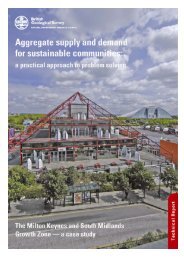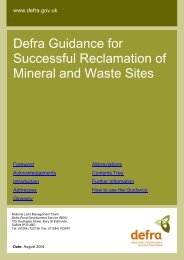creating environmental improvements through biodiversity
creating environmental improvements through biodiversity
creating environmental improvements through biodiversity
You also want an ePaper? Increase the reach of your titles
YUMPU automatically turns print PDFs into web optimized ePapers that Google loves.
Sustainable Aggregates Creating Environmental Improvements <strong>through</strong> Biodiversity<br />
The report suggests that the SEA website could be used to gather information on any testing of the<br />
techniques by MPAs.<br />
It states that data relating to SEA should be more widely available in a useful format and further tested for<br />
suitability to the techniques.<br />
IMPROVING ENVIRONMENTAL OUTCOMES FOR THE MINERALS<br />
INDUSTRY AND STATUTORY ENVIRONMENTAL BODIES – A REVIEW OF<br />
BARRIERS AND OPPORTUNITIES.<br />
FINAL REPORT, SECTION 3 (THE CENTRE FOR SUSTAINABILITY AT TRL<br />
LIMITED, UNPUBLISHED PROJECT REPORT)<br />
Vicky McColl-Grubb, Layla Baldachin and Colin Treleven. March 2004<br />
Project Type:<br />
Collation of opinions from the minerals industry and statutory bodies<br />
Site: TRL headquarters<br />
Project Aim:<br />
To examine problems and opportunities facing both minerals industry and statutory bodies in improving<br />
<strong>environmental</strong> and operational outcomes<br />
Main Methods:<br />
Workshop for members of the minerals industry, minerals planners from local authorities, and English Nature<br />
(comments also sought from English Heritage and the Environment Agency)<br />
Output:<br />
Description of roles of different statutory bodies<br />
Tables describing issues highlighted by the minerals industry and statutory bodies:<br />
Planning stage -<br />
Barriers highlighted by minerals industry:<br />
• Lack of experienced staff at statutory bodies due to a high staff turnover<br />
• English Heritage’s blanket approach to archaeological investigations<br />
• Statutory bodies being too prescriptive with policy. Linked to inexperienced staff<br />
Barrier highlighted by statutory bodies:<br />
• Lack of clarity in minerals industry on best type of habitat restoration. Often a mixture of several habitat<br />
types designed by a landscape architect<br />
Opportunity highlighted by all:<br />
• Environment Agency’s new standard response to planning applications as part of new Planning Bill. This is<br />
likely to be used for smaller applications and allow more time to be spent on minerals applications<br />
Extraction stage -<br />
Barriers highlighted by minerals industry:<br />
• Prolonged waiting for consents posing a business risk<br />
• Extreme caution by statutory bodies. Linked again to inexperienced staff<br />
Restoration stage -<br />
Opportunity highlighted by the statutory bodies:<br />
• Need for better understanding of sustainable restoration among planners – EN provide educational<br />
72

















